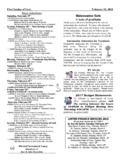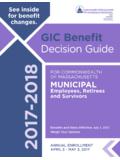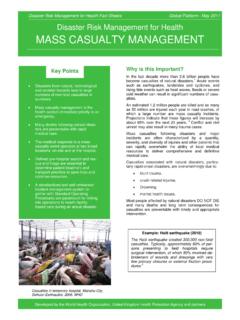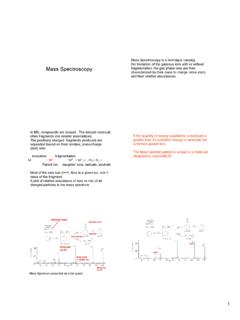Transcription of Let’s Find the Mass & the Volume
1 Science Enhanced Scope and Sequence Grade 2 virginia department of education 2012 1 Let s find the mass & the Volume Strand Matter Topic Measurement of the mass and Volume of solids and liquids Primary SOL The student will investigate and understand basic properties of solids, liquids and gases. Key concepts include b) measurement of the mass and Volume of solids and liquids. Related SOL The student will demonstrate an understanding of scientific reasoning, logic, and the nature of science by planning and conducting investigations in which a) observations and predictions are made and questions are formed; c) observations are repeated to ensure accuracy; e) length, Volume , mass , and temperature are measured in metric units and standard English units using the proper tools; h) data are collected and recorded, and bar graphs are constructed using numbered axes.
2 Background Information A solid is a type of matter with atoms that have relatively low energy and low movement. Because of this a solid has a defined mass , Volume , and shape. A liquid is a type of matter with atoms that have a higher level of energy and movement than solids. This means that liquids have a defined mass and Volume , but take on the shape of the containers they are stored in. mass and weight are often used to mean the same thing. It is important for students to begin to differentiate between the two. mass is a measure of the amount of matter in an object. Weight measures the pull of gravity on an object and changes when the gravitational pull changes.
3 For example, if you were standing on the moon, which has a weaker gravitational pull than Earth, you would weigh less (1/6 of your weight here on Earth), but you would still have the same amount of matter in your body as you do on Earth. Your mass would be the same. Students are not expected to understand the difference between mass and weight at this level. The use of the term weight with the balance perpetuates the misconception that weight and mass are interchangeable or are measuring the same thing. A better way to introduce the students to the balance is to introduce the term mass . Volume is defined as the amount of space, measured in cubic units, that an object or substance occupies.
4 mass is a measure of the quantity of matter present in an object. Volume is a measure of how much space it occupies. Materials For each of center: common classroom objects (some with a mass of less than a gram, some with a mass of a gram, and some with a mass of more than a gram), bathroom scales, set of liter containers, large container of water, balance, paper towels For each student: one copy of recording sheet for mass . Science Enhanced Scope and Sequence Grade 2 virginia department of education 2012 2 Vocabulary solid, liquid, mass , Volume Student/Teacher Actions (what students and teachers should be doing to facilitate learning) Introduction 1. Set up the centers.
5 There will be three different centers, but you can set up multiple centers that are identical in order to keep the student teams to the size of two to three students per team. By the end of this lesson, all students should have had the opportunity to work in all three of the centers. 2. Review with the students the characteristics of a solid and a liquid. 3. Ask students if they know what the terms mass and Volume mean. After a few students share their ideas, define the terms. 4. Review the use of a balance or a scale and its proper use. Review with the students which tools are used to measure mass and Volume . 5. Review the use of measuring cups and how to use them properly.
6 6. Explain to the students that they will be working in teams of two to three students to practice measuring the mass and the Volume of different items. 7. Explain that they are going to use scales to measure the mass of solids. Introduce customary units of measure and explain that they will use grams as the unit of measure. Pass around an object that weighs about a gram so students have a sense of its mass . 8. Discuss with students what it means to estimate. Procedure 1. Set up the following three centers. (Again, if needed you can set up multiple identical centers in order to keep the student teams to the size of two to three students per team.) Center 1 Measuring mass a.
7 Center 1 Materials: balance or scale, multiple items for students to measure ( , rock, magic marker, student notebook, textbook, etc.), student sheet Measuring mass b. Student directions include: i. Pick up one of the objects. ii. Estimate how much in grams you think its mass is. Record your estimate. iii. Using the balance or scale, measure the mass of the object. Record the actual measurement. iv. Answer the questions. Center 2 Measuring the Volume of a Liquid Science Enhanced Scope and Sequence Grade 2 virginia department of education 2012 3 a. Center 2 Materials: plastic dishpan with water in it, cup measure, several different empty containers ( , plastic glass, spoon, plastic water bottle, small pan, small bowl, etc.)
8 Optional: a funnel to use when filling the containers with water b. Student directions include: i. Pick one container at a time. Estimate how many cups of water the container will hold. Record your estimate. ii. Carefully fill the container with water. Record the actual amount of water the container can hold. iii. Carefully pour the water back into the dishpan. iv. Answer the questions. Center 3 Comparing Objects a. Center 3 Materials: various balls (you should include at least one ping pong ball, one golf ball, one old baseball that can be put into water, one playground ball. You may include other balls as well.), dishpan with water in it, balance or scale b. Student directions include: i.
9 Put the balls in the center in sequential order by size, smallest to largest. Record your sequence. ii. Estimate the mass of each of the balls. Record your estimates. Put the balls in sequence according to your estimates (from smallest to largest) and record your sequence. iii. Measure the mass of each of the balls. Record your measurements. Put the balls into sequence according to your measurements (from smallest to largest) and record your sequence. iv. Answer the questions. 2. Bring students together as a group. 3. Discuss their work in each of the centers and relate it to how they would use estimation, measurement, and sequencing in experiments they do. Assessment Questions o Did your estimates of an object s mass improve?
10 Why? o Did your estimates of an object s Volume improve? Why? o How could you determine the Volume of a shoe box? Journal/writing prompts o Explain the term mass . How might you determine the mass of an object? Science Enhanced Scope and Sequence Grade 2 virginia department of education 2012 4 o Make a list of objects that you think have a mass of less than a gram (about a gram, more than a gram) o Would a soda can or a milk container have a greater Volume ? Explain your answer. Other o Gather objects with a mass of less than a gram, about a gram and greater than a gram. Have students hold it and then use their thumbs (down, sideways, or up) to show what they think the mass of each object is.

















